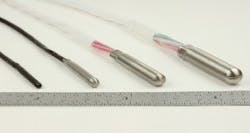Instead of testing a small (e.g., 5-10 gram) sample, the in-line systems monitors the complete batch of product. Installing the instrument requires an initial calibration exercise to compare the reading on the sensor to actual readings from lab tests, for each product to be dried.
GEA Pharma also recently announced that a major pharma manufacturer is evaluating its Lyoplus mass spectrometer for gathering freeze-dryer data. According to GEA, the un-named manufacturer has confirmed several benefits: the ability to detect small silicone oil leaks inside the dryer; to monitor moisture content within the freeze drying chamber; and to identify the end point of primary and secondary drying. The manufacturer is currently fitting another five lyophilizers with Lyoplus.
Burns Engineering recently introduced its Series S autoclave temperature sensors, with an operating range of -50°C to 200°C. The sensor family includes chamber and load probes, light/heavy/xtreme duty designs as well as standard or precision accuracy. Chamber wall feed-through options, including sanitary caps and multi-probe ports, are available as well.
This winter, the Process Analytics division of Mettler Toledo introduced a total organic carbon (TOC) sensor, the 5000TOCi, with its Intelligent Sensor Management (ISM)—a company initiative to build self-diagnostic features into its devices. The 5000TOCi can be used for applications such as WFI, reverse osmosis membranes, resin bed performance, organics shedding, and quality of final rinse water.
The product is a reliable, sophisticated, and intuitive measurement system by combining a proven and dependable TOC analysis platform with advanced user interface and Intelligent System Management sensor diagnostics,” says product manager Steven Carelli. Combined with Thornton’s M800 multi-parameter transmitter, it integrates on-line TOC measurement with up to four sensors--up to two or four sensors for conductivity, pH, ORP, dissolved ozone or dissolved oxygen, in addition to two pulsed flow sensors. Among the benefits, says Mettler, is that the 5000TOCi “drastically reduces record keeping for the release of water through simplified data collection with innovative Peak and Average TOC measurements.”
Finally, blister packaging solutions provider Bilcare Research has launched BilcareOptima, what it calls “the pharmaceutical industry‘s most scientifically thorough method to determine ideal packaging solutions for oral dose products.” The product is a forced drug degradation analysis that determines a product’s susceptibility to humidity, temperature and light and other environmental factors, in order to recommend a packaging solution before the product is ever packaged. The company says it uses a proprietary battery of “all-encompassing tests” to do the analysis.






